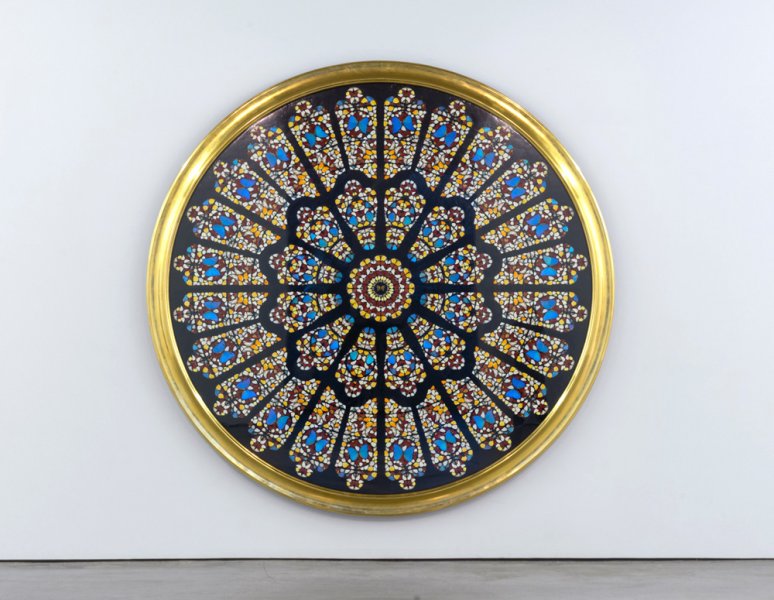Damien Hirst
Damien Hirst (1965, Bristol, UK).
Lives and works in Devon (UK).
“I just wanted to find out where the boundaries were. So far I’ve found there aren’t any. I just wanted to be stopped, and no one will stop me.”
– Damien Hirst
Damien Hirst, an iconic figure in the British art scene, stands as one of the most influential and successful artists of our era. Throughout his illustrious 30-year career, he has not only redefined the role of an artist but also transformed it into that of a contemporary impresario, revolutionizing the very essence of contemporary art.
Hirst’s body of work is incredibly diverse and delves deeply into the fundamental questions of human existence. He fearlessly explores subjects of life, death, art, religion, science, and technology. Central to his artistic exploration is the theme of mortality, as he once stated, “There has only ever been one idea, and it’s the fear of death; art is about the fear of death.” A master of sensationalism, provocation, and self-promotion, Hirst’s art challenges conventional notions of what art should be.
Hailing from Bristol and raised in Leeds, Hirst made his way to London in 1986 to pursue his studies at Goldsmith’s College. During his time as a student in 1988, he orchestrated a legendary exhibition called ‘Freeze’, which became a defining moment for the internationally renowned ‘Young British Artists’ (YBA) movement.
In 1992, Hirst gained public recognition when his work was featured in the monumental Young British Artists exhibition at the Royal Academy of Arts. The centerpiece of this exhibition was his daring and controversial installation titled “The Physical Impossibility of Death in the Mind of Someone Living” (1991). The installation featured a 12-foot tiger shark preserved in formaldehyde, that challenged traditional perceptions of art and confronted audiences with the raw reality of life and death. The shark became a symbol of Hirst’s groundbreaking Natural History series, where he continued to use formaldehyde to preserve various animal bodies, presenting them as provocative works of art.
In 1995, Hirst received the prestigious Turner Prize awarded for his thought-provoking piece “Mother and Child (Divided)” (1993). The work depicted a cow and calf dissected and preserved in formaldehyde and was showcased at the 1993 Venice Biennale. In 1997 Hirst’s work was featured in the famous Sensation exhibition at the Royal Academy of Arts, further solidifying his reputation as a sensational and most provocative artist of the time.
Among his other iconic works is the Spot paintings series, which emerged in the mid-1980s, receiving both acclaim and criticism for its innovative machine-like industrial uniformity. These works became the artist’s response to the perceived “coldness of minimalism” and reflected Hirst’s fascination with abstract expressionism. The paintings featured uniquely colored dots meticulously arranged in a precise grid, suggesting order and structure at first glance. However, upon closer look, an underlying sense of chaos and unease emerged. Hirst explained this effect as stemming from the lack of repeated colors, which prevents the usual harmony created by balancing different chords of color. Despite this subliminal sense of unease, the vibrant colors projected by the paintings evoke a sense of joy, creating an intriguing juxtaposition of emotions within each work.
“The Spot Paintings…always look happy, although there’s an unease there too because the colours don’t repeat when you expect them to.”
– Damien Hirst
Hirst’s signature works involving butterflies, both alive and preserved in paint, made their debut in the early 1990s. The groundbreaking exhibition ‘In and Out of Love’ in Soho featured live butterflies emerging from pupae affixed to canvases. Visitors were invited to witness an ever-changing life cycle of birth and death as the butterflies, confined within a gallery room, lived out their short existence as part of the art installation.
In his ambitious series called Kaleidoscope Paintings, Hirst used thousands of real butterfly wings arranged in intricate concentric patterns over the household paint, evoking imagery of Buddhist mandalas or stained-glass rose windows. Each vibrant circular mosaic of the series held its unique symbolism, supported by the astonishingly symmetrical arrangement of the butterfly wings, the colors, and the title of the artwork. ‘Butterfly’ motif, both brutal and hypnotizing, seamlessly blend the ephemeral elegance of life with the alluring shine of consumer culture, reflecting about transitory nature of beauty, mortality and aesthetics.
Hirst’s renowned Spin paintings series exemplifies the technique of pouring household gloss onto a mechanically rotating canvas, imbuing the artwork with a tangible sense of movement. By relinquishing direct control over the paint application and embracing unpredictability, Hirst cleverly paid homage to Jackson Pollock’s action paintings. Simultaneously, he also referenced Marcel Duchamp’s ready-mades by rejecting manual intervention in the production process.
Modern medicine serves as a defining theme in Hirst’s work, and his renowned series of ‘Medicine Cabinets’ and ‘Instrument Cabinets’ exemplify his exploration of the crossroads between art and life science. Physiology, pathology, natural history, and pharmacology become focal points, as Hirst ingeniously employs their credibility and authority to shock viewers, compelling them to confront fundamental aspects of existence. The meticulously arranged pharmaceutical supplies encased behind glass stand as a poignant tribute to society’s unwavering trust in the life-saving capabilities of scientific advancement, while challenging the inevitability of death.
“I know the medicine cabinets work, but in many ways. I like all the readings, if you see them as power structures, a society, or as metaphor for the human body or even as a comment on capitalism or consumerism…or pro-medicine or anti-medicine – they are about all these things, even if you just think it’s weird to see them in a gallery.”
– Damien Hirst
In 2007, Hirst produced one of his most controversial works, ‘For the Love of God’, featuring a platinum-cast human skull studded with 8,601 diamonds. In 2017, during the Venice Biennale, Hirst unveiled his monumental project ‘Treasures from the Wreck of the Unbelievable’, consisting of approximately 190 works displayed in museums Punta della Dogana and Palazzo Grassi.




